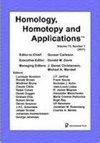On cohomology in symmetric tensor categories in prime characteristic
IF 0.5
4区 数学
Q2 MATHEMATICS
引用次数: 3
Abstract
We describe graded commutative Gorenstein algebras ${\mathcal E}_n(p)$ over a field of characteristic $p$, and we conjecture that $\mathrm{Ext}^\bullet_{\mathsf{Ver}_{p^{n+1}}}(1,1)\cong{\mathcal E}_{n}(p)$, where $\mathsf{Ver}_{p^{n+1}}$ are the new symmetric tensor categories recently constructed in \cite{Benson/Etingof:2019a,Benson/Etingof/Ostrik,Coulembier}. We investigate the combinatorics of these algebras, and the relationship with Minc's partition function, as well as possible actions of the Steenrod operations on them. Evidence for the conjecture includes a large number of computations for small values of $n$. We also provide some theoretical evidence. Namely, we use a Koszul construction to identify a homogeneous system of parameters in ${\mathcal E}_n(p)$ with a homogeneous system of parameters in $\mathrm{Ext}^\bullet_{\mathsf{Ver}_{p^{n+1}}}(1,1)$. These parameters have degrees $2^i-1$ if $p=2$ and $2(p^i-1)$ if $p$ is odd, for $1\le i \le n$. This at least shows that $\mathrm{Ext}^\bullet_{\mathsf{Ver}_{p^{n+1}}}(1,1)$ is a finitely generated graded commutative algebra with the same Krull dimension as ${\mathcal E}_n(p)$. For $p=2$ we also show that $\mathrm{Ext}^\bullet_{\mathsf{Ver}_{2^{n+1}}}(1,1)$ has the expected rank $2^{n(n-1)/2}$ as a module over the subalgebra of parameters.素数特征下对称张量范畴的上同调
我们描述了特征$p$域上的分次交换Gorenstein代数${\mathcal E}_n(p)$,并推测$\mathrm{Ext}^\bullet_{\mathsf{Ver}_{p^{n+1}}}(1,1)\cong{\mathcal E}_{n}(p)$,其中$\mathsf{Ver}_{p^{n+1}}$是最近在{Benson/Etingof:2019a,Benson/Edingof/Osterik,Coulenbier}中构造的新的对称张量范畴。我们研究了这些代数的组合数学,以及与Minc配分函数的关系,以及Steenrod运算对它们的可能作用。该猜想的证据包括对小数值$n$的大量计算。我们还提供了一些理论证据。也就是说,我们使用Koszul构造来识别${\mathcal E}_n(p)$中的齐次参数系统和$\mathrm{Ext}^\bullet_{Ver}_{p^{n+1}}}(1,1)$。如果$p=2$,则这些参数的阶数为$2^i-1$;如果$p$为奇数,则对于$1\le i\le n$,这些参数具有$2(p^i-1)$。这至少表明$\mathrm{Ext}^\bullet_{\mathsf{Ver}_{p^{n+1}}}(1,1)$是一个有限生成的分次交换代数,其Krull维数与${\mathcal E}_n(p)$相同。对于$p=2$,我们还表明$\mathrm{Ext}^\bullet_{\mathsf{Ver}_{2^{n+1}}(1,1)$作为参数子代数上的模具有期望秩$2^{n(n-1)/2}$。
本文章由计算机程序翻译,如有差异,请以英文原文为准。
求助全文
约1分钟内获得全文
求助全文
来源期刊
CiteScore
1.10
自引率
0.00%
发文量
37
审稿时长
>12 weeks
期刊介绍:
Homology, Homotopy and Applications is a refereed journal which publishes high-quality papers in the general area of homotopy theory and algebraic topology, as well as applications of the ideas and results in this area. This means applications in the broadest possible sense, i.e. applications to other parts of mathematics such as number theory and algebraic geometry, as well as to areas outside of mathematics, such as computer science, physics, and statistics. Homotopy theory is also intended to be interpreted broadly, including algebraic K-theory, model categories, homotopy theory of varieties, etc. We particularly encourage innovative papers which point the way toward new applications of the subject.

 求助内容:
求助内容: 应助结果提醒方式:
应助结果提醒方式:


